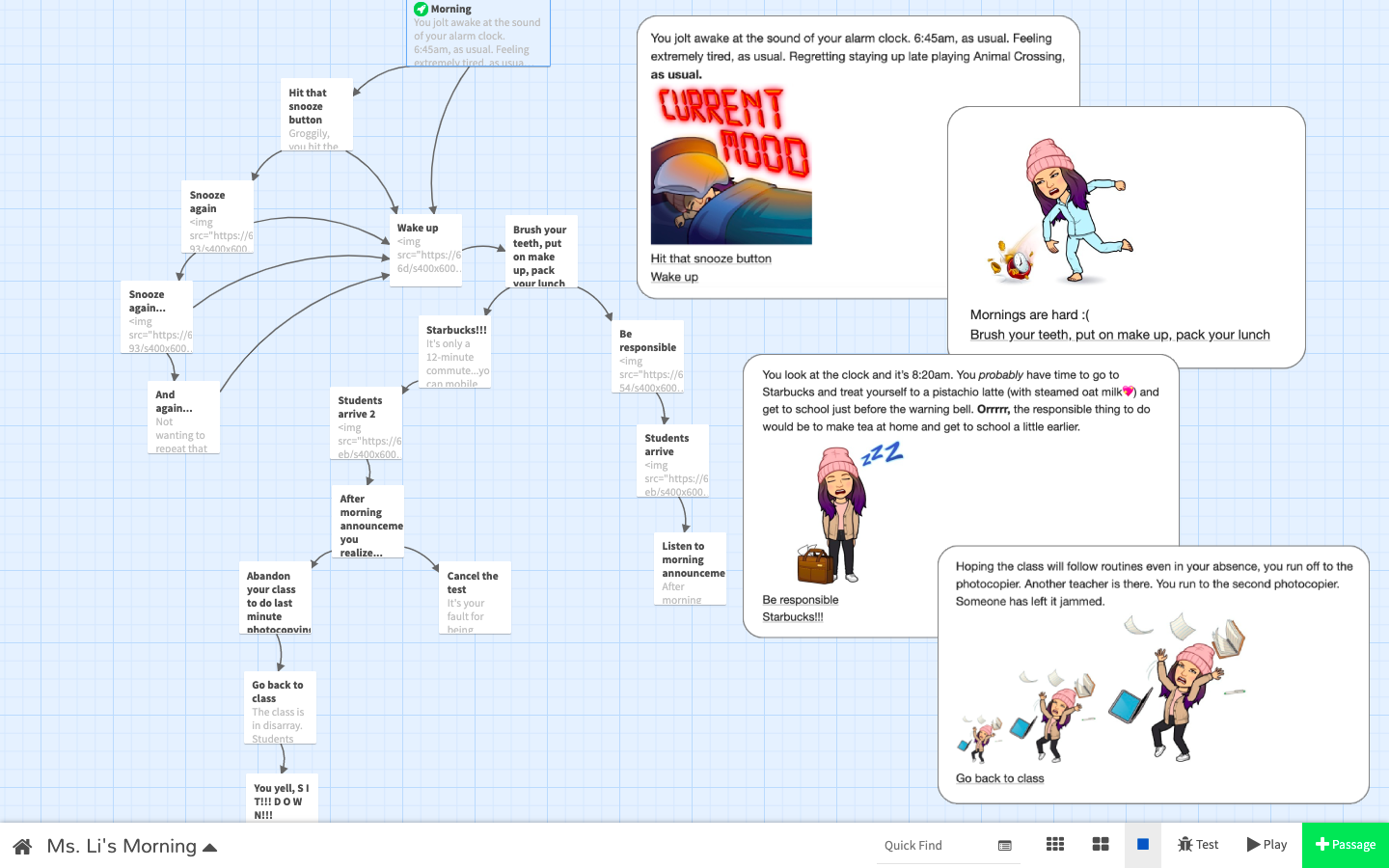
Twine: Ms. Li’s Morning (.zip file, right click + open in new tab to download)
This Twine will lead you through a typical morning in my life. All aboard the struggle bus (ꐦ ಠ皿ಠ ). Making this Twine was a lot of fun and I can see myself getting very carried away with it. I wish I knew about this resource when I did my fractured “choose your own adventure” fairytales unit two years ago (I manually created PowerPoint slides to get them to link to different outcomes. It was so laborious and didn’t fully capture the ‘choose your own’ spirit).
At first, I tried to develop the different level of branches all at the same time, but quickly realized it was really difficult to keep track of the story. Later on, I fully developed one storyline (e.g., went to Starbucks–>sneaking off to do photocopying) before completing the other (e.g., went to Starbucks–>cancel the math test). If I were to do this again, or teach my students to use Twine, I would get them to map it out on paper first. I felt like I didn’t fully take advantage of the different functions Twine allowed. In the game, the temple of No, I could see how certain paths looped back or connected to other plot points (e.g., when having to select between three doors), or how certain texts would only appear after I clicked certain words. If I had more time, I would explore the various assets to create a more interactive experience.
In chapter 3 of Writing Space: Computers, Hypertext, and the Remediation of Print, Bolter (2001) posits that though texts are muted in the printed book and the web “offers us the experience of moving through a visual and conceptual space different from the space of the book,” much of our knowledge of hypertexts depend on our previous understanding of print (p. 45). This is true when designing this Twine as I frequently referred back to my own experiences with Choose Your Own Adventure chapter books. Even more so, when hypertexts reference things related to the page I’m currently reading, I am reminded of the footnotes that would’ve appeared in printed texts. What is different is that I mostly ignore the footnotes but am willing to open links in a ‘new tab’ for viewing after. Lately, I’ve been using the haptic touch on my phone for the “look up” function for even more immediate information. I like the way Bolter describes this as the webpages “coming” to me, because this is true (p. 29)! I am sitting at my desk, on my laptop, and am frequently presented with all these links I could choose to open (this brings to mind wikipedia spirals I have gone on).
Connected to this week’s ideas on the reinvention of writing, it is interesting to compare Twine with these published CYOA novels. The temple of No has text, auditory, and visual components that add to the overall product. Not only that, creators can always go back and edit the Twine to make it “more current” or to extend the story, if desired. Compare that to CYOA novels that feel dated after a decade. When information is published and printed, their stories become static. Even the Bolter chapter, published in 2001, feels dated with its spelling of the World Wide Web, a phrase we seldom use anymore when referring to the internet.
In the podcast The Allusionist, McCulloch mentions how Internet language shifts rapidly so there is no reason to enshrine it. Emojis, which can alter the sentence that comes before them, also depend on context and a mutual interpretation of the code in order for both parties to understand its linguistic context (8:31). A purple heart means one thing to a BTS fan, but another to someone who doesn’t understand the code. Has anyone used![]() with you? This has also led me to reflect how I type on Microsoft Teams with my students. I admit, I go full on lowercase when replying to them because that is how I write on social media. It requires intentional effort to put back the capitals and punctuation, as well, intentionally adding in an emoji or two to not come across as too stiff or overly formal.
with you? This has also led me to reflect how I type on Microsoft Teams with my students. I admit, I go full on lowercase when replying to them because that is how I write on social media. It requires intentional effort to put back the capitals and punctuation, as well, intentionally adding in an emoji or two to not come across as too stiff or overly formal.
References
Bolter, J.D. (2001). Writing Space: Computers, hypertext, and the remediation of print. Mahway, NJ: Lawrence Erlbaum Associates, pp. 27-46.
Zaltzman, H. (Host). (2019, July 13). New rules (No. 102) [Audio podcast episode]. In The Allusionist. https://www.theallusionist.org/allusionist/new-rules
[Edited on February 17, fixing the incorrect URL under the Zaltzman reference]